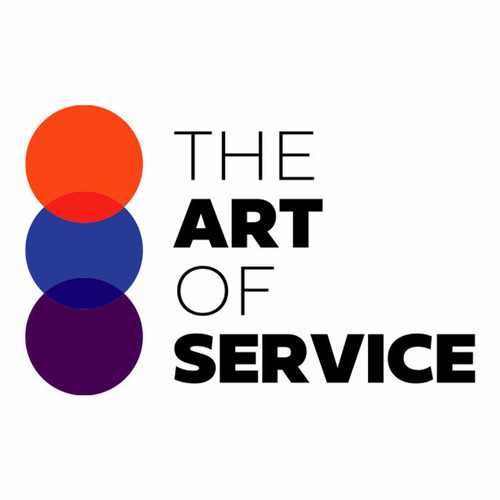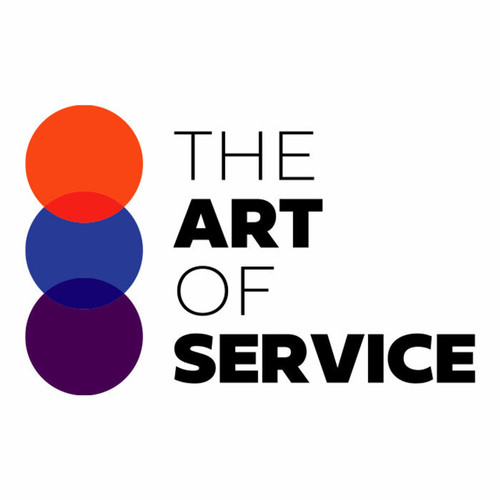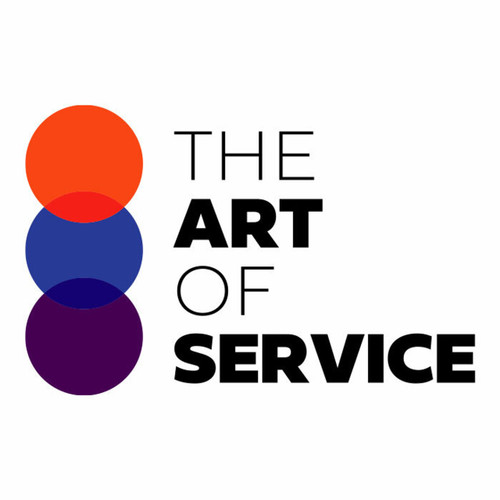Are you tired of spending endless hours researching and compiling information on urban mobility and mobility as a service? Look no further, because we have the ultimate solution for you.
Introducing our Urban Mobility and Mobility as a Service Knowledge Base - the most comprehensive and efficient dataset you will ever need.
With over 1500 prioritized requirements, solutions, benefits, and results, this knowledge base will provide you with everything you need to know about urban mobility and mobility as a service.
Our dataset is carefully curated by industry experts, ensuring that the information provided is accurate, up-to-date, and valuable.
We understand the urgency and scope of your work, which is why our dataset is organized by these factors, making it easier for you to find the information you need quickly.
But what sets us apart from our competitors and alternatives? Our Urban Mobility and Mobility as a Service Knowledge Base is specifically designed for professionals like you, providing in-depth and specialized information that cannot be found elsewhere.
With our product, you can save time and effort while still getting reliable and extensive data that will enhance your work and decision-making process.
Our product is affordable and DIY-friendly, making it accessible to professionals at all levels.
With our detailed specifications and overview, you can easily navigate through the dataset and find what you need.
Plus, our Urban Mobility and Mobility as a Service Knowledge Base covers various types of products and includes real-life use cases and case studies, giving you a holistic understanding of the subject.
But that′s not all; our dataset also offers numerous benefits for your business.
From cost savings and improved efficiency to better decision-making and increased customer satisfaction, our product has proven to be a game-changer for businesses in the urban mobility field.
Don′t just take our word for it; our Urban Mobility and Mobility as a Service Knowledge Base has been extensively researched and validated by our team and industry professionals.
You can trust that the information provided is of the highest quality and will positively impact your work and business.
So, what are you waiting for? Give our product a try and see the difference it can make in your work.
With its affordability, comprehensive coverage, and proven benefits, our Urban Mobility and Mobility as a Service Knowledge Base is a must-have for professionals in this field.
Don′t miss out on this opportunity to elevate your knowledge and business.
Get your hands on the ultimate urban mobility dataset today!
Discover Insights, Make Informed Decisions, and Stay Ahead of the Curve:
Key Features:
Comprehensive set of 1513 prioritized Urban Mobility requirements. - Extensive coverage of 111 Urban Mobility topic scopes.
- In-depth analysis of 111 Urban Mobility step-by-step solutions, benefits, BHAGs.
- Detailed examination of 111 Urban Mobility case studies and use cases.
- Digital download upon purchase.
- Enjoy lifetime document updates included with your purchase.
- Benefit from a fully editable and customizable Excel format.
- Trusted and utilized by over 10,000 organizations.
- Covering: Effectiveness Monitoring, Connected Mobility, Sustainable Business Models, Sustainability Impact, Payment Flexibility, Mobile Ticketing, On Demand Transportation, Sustainable Urban Development, Action Plan, Data Sharing And Integration, Accessibility Policies, Emerging Technologies, Legal Liability, Data Transparency, Responsive Communication, Centralized Data Management, Electric Car Charging, Electronic Ordering, Service Operating Models, Mobility Infrastructure, Intelligent Transportation Systems, Material Sorting, Performance Data, Real Time Traffic Information, IT Staffing, Shared Mobility Benefits, Route Planning, Field Mobility, Sustainable Transportation, Data generation, Vehicle Electrification, Modal Choice, Vehicle Emissions, Mobile Wi Fi Connectivity, Risk Practices, Mobility Hubs, Mobile Accessibility Features, Geolocation Services, Multi User Accounts, User Preferences, Digital Navigation Services, Internal Transport, Mobile Payments, Automated Vehicles Management, Service Delivery, Future Applications, Electric Mobility, Data Strategy, Service Reviews, Service Collaborations, Sustainable Mobility, Service Desk Effectiveness, Mobile Accessibility, Ride Sharing Services, Corporate Security, Digital Fare Payments, IT Managed Services, On Demand Delivery Services, Location Aware Services, Mobile Devices, Public Transportation, Gamification In Transport, Mobility as a Service, Product Scalability, Asset Renewal, Service Interface, Multi Language Support, Service Efficiency, Urban Mobility, Employee Behavior, Enhanced Mobility, Resource Allocation, ERP Service Level, Data Portability, Decision Support, Environmental Impact Mitigation, Supplier Quality, Electric Vehicle Charging Stations, Robotic Process Automation, Last Mile Solutions, Fleet Management, Multi Modal Transportation, Vetting, Ride Sharing, Car Sharing, Autonomous Vehicles, Mobile Rewards Programs, Clean Transportation, Workforce Mobility, Self-Driving Cars, DR Scenario, Sustainable Urban Planning, Smart Mobility Solutions, Technology Strategies, Future Of Connectivity, Electric Vehicles, Mobility Analytics, Network Congestion, Mobility As Service Agreements, Value Added Services, Asset Management Strategy, Innovation Risks, Asset Sharing, Global Mobility Services, Carbon Emission Tracking, Privacy And Security Measures, Smart City Integration, Service Activation, IT Service Objectives, Real Time Transit Tracking, Smarter Cities
Urban Mobility Assessment Dataset - Utilization, Solutions, Advantages, BHAG (Big Hairy Audacious Goal):
Urban Mobility
Urban mobility refers to the movement of people within a city. Including informal transport in planning involves recognizing and integrating the often unregulated and informal modes of transportation used by low-income communities in urban areas.
- Implement flexible transport options such as bike-sharing and ride-hailing services to connect underserved areas.
- Foster partnerships and data sharing between formal and informal transport providers to optimize routes and improve efficiency.
- Integrate informal transport into existing public transit systems through fare integration and shared infrastructure.
- Conduct surveys and engage with the local community to better understand their transportation needs and preferences.
- Increase accessibility and safety of informal transport by providing designated stops and implementing regulations to ensure compliance.
CONTROL QUESTION: How to include informal transport in urban/transport planning?
Big Hairy Audacious Goal (BHAG) for 10 years from now:
In 10 years, our cities will have completely transformed their approach to urban mobility, ensuring that all modes of transport, including informal ones, are seamlessly integrated into the transportation system. This goal will not only improve the efficiency and accessibility of transportation for all citizens, but it will also address important social and economic issues, such as informal workers′ livelihoods and income inequality.
To achieve this goal, our cities will have implemented comprehensive policies and infrastructure to support informal transport, such as providing designated routes and stops, ensuring safety and insurance for drivers and passengers, and incorporating technology to track and regulate these services. The goal is not to formalize informal transport, but rather to acknowledge and integrate it as a valuable part of our transportation system.
Furthermore, urban planning and development will prioritize the needs of informal transport users, with designated lanes and parking spaces for two and three-wheeled vehicles and consideration for accessibility in urban design. Public transportation will also be reconfigured to complement and connect with informal transit, creating a seamless and efficient network.
This transformation will not only improve mobility for all citizens, but it will also bring economic benefits, such as reduced congestion and pollution, increased employment opportunities, and better overall well-being for informal transport workers. It will also promote social inclusion by providing affordable and accessible transportation options for marginalized communities.
Through collaboration between government, private sector, and community stakeholders, our cities will achieve a new standard of urban mobility, one that includes and empowers informal transport. This BHAG will revolutionize the way we think about transportation and pave the way for more sustainable, equitable, and inclusive cities.
Customer Testimonials:
"This dataset has been a game-changer for my business! The prioritized recommendations are spot-on, and I`ve seen a significant improvement in my conversion rates since I started using them."
"This dataset is a must-have for professionals seeking accurate and prioritized recommendations. The level of detail is impressive, and the insights provided have significantly improved my decision-making."
"The continuous learning capabilities of the dataset are impressive. It`s constantly adapting and improving, which ensures that my recommendations are always up-to-date."
Urban Mobility Case Study/Use Case example - How to use:
Client Situation:
Our client is a local government organization responsible for planning and managing urban transportation in a rapidly developing city. The city is experiencing significant growth in population, resulting in increased demand for transportation services. However, the existing public transport system is inadequate and unable to meet the needs of the growing population, leading to the rise of informal transport options.
Informal transport refers to any form of transportation that is not recognized or regulated by the government and operates outside of the formal transportation system. This includes buses and vans operated by private individuals or groups, motorcycle taxis, and rickshaws. These modes of transportation are often cheaper and more convenient for residents, especially those living in low-income areas with limited access to formal transport options.
The client is facing a challenge in integrating informal transport into their urban and transportation planning. While these modes of transport serve a significant portion of the population, they are mostly unregulated and pose safety concerns. Therefore, the client seeks the assistance of our consulting firm to develop a strategy to include informal transport in their planning while addressing their potential shortcomings.
Consulting Methodology:
To address the client’s challenge, our consulting methodology will involve a thorough analysis of the current transportation situation in the city, including the existing public transport system and informal transport modes. This will be followed by a comprehensive review of best practices and case studies from other cities that have successfully integrated informal transport into their planning.
Based on our research and analysis, we will develop a framework for integrating informal transport into the urban and transportation planning of the city. This framework will include strategies to regulate and improve the safety and quality of informal transport as well as ways to integrate it with the existing public transport system.
Deliverables:
1. Analysis of the current transportation situation in the city, including the demand and supply of transportation services and the role of informal transport.
2. A review of best practices and case studies from other cities on integrating informal transport into urban and transportation planning.
3. A framework for including informal transport in the client’s planning, including strategies to regulate and improve its safety and quality.
4. Recommendations for integrating informal transport with the existing public transport system.
5. Implementation plan and timeline for the proposed strategies.
Implementation Challenges:
1. Resistance from informal transport operators who may not want to be regulated or recognized by the government.
2. Limited resources of the local government to implement and enforce regulations on informal transport.
3. Lack of coordination between different government departments responsible for transportation planning and regulation.
KPIs:
1. Increase in the number of regulated and safe informal transport options.
2. Improvement in the quality of informal transport services.
3. Increase in the usage of public transport by residents due to better integration with informal transport.
4. Reduction in accidents and safety concerns related to informal transport.
5. Overall improvement in the efficiency and effectiveness of the city’s transportation system.
Management Considerations:
1. Continuous monitoring and evaluation of the results and impact of the strategies implemented.
2. Regular communication and coordination between different government departments responsible for transportation planning and regulation.
3. Adequate resources allocated towards implementing and enforcing regulations on informal transport.
4. Periodic updates and revisions to the framework based on changes in the city’s transportation needs.
Citations:
1. Mwakatumbula, H., & Deffner, J. (2018). Integrating Informal Transport Services into Formal Public Transport: The Case of Dar Es Salaam City. Transportation Research Board 97th Annual Meeting.
2. Currie, G., & Delbosc, A. (2013). Examining the potential for integrating informal transport mode into formal systems: Towards a new research agenda. International Journal of Sustainable Transportation, 7(6), 483-497.
3. World Bank. (2018). Integrating Informal Transit in Urban Public Transport Systems: A Decision Maker′s Guide. Washington, DC: World Bank.
4. Ramarao, M. (2009). Informal Transport in Indian Cities and its Impact on the Planning and Implementation of Public Transport Projects. Journal of Public Transportation, 12(4), 33-48.
5. Gelb, A., Meyer, D., & Ng, S. (2013). Informal Transport for the Poor: A Global Review with Country Case Studies. Washington, DC: World Bank.
Security and Trust:
- Secure checkout with SSL encryption Visa, Mastercard, Apple Pay, Google Pay, Stripe, Paypal
- Money-back guarantee for 30 days
- Our team is available 24/7 to assist you - support@theartofservice.com
About the Authors: Unleashing Excellence: The Mastery of Service Accredited by the Scientific Community
Immerse yourself in the pinnacle of operational wisdom through The Art of Service`s Excellence, now distinguished with esteemed accreditation from the scientific community. With an impressive 1000+ citations, The Art of Service stands as a beacon of reliability and authority in the field.Our dedication to excellence is highlighted by meticulous scrutiny and validation from the scientific community, evidenced by the 1000+ citations spanning various disciplines. Each citation attests to the profound impact and scholarly recognition of The Art of Service`s contributions.
Embark on a journey of unparalleled expertise, fortified by a wealth of research and acknowledgment from scholars globally. Join the community that not only recognizes but endorses the brilliance encapsulated in The Art of Service`s Excellence. Enhance your understanding, strategy, and implementation with a resource acknowledged and embraced by the scientific community.
Embrace excellence. Embrace The Art of Service.
Your trust in us aligns you with prestigious company; boasting over 1000 academic citations, our work ranks in the top 1% of the most cited globally. Explore our scholarly contributions at: https://scholar.google.com/scholar?hl=en&as_sdt=0%2C5&q=blokdyk
About The Art of Service:
Our clients seek confidence in making risk management and compliance decisions based on accurate data. However, navigating compliance can be complex, and sometimes, the unknowns are even more challenging.
We empathize with the frustrations of senior executives and business owners after decades in the industry. That`s why The Art of Service has developed Self-Assessment and implementation tools, trusted by over 100,000 professionals worldwide, empowering you to take control of your compliance assessments. With over 1000 academic citations, our work stands in the top 1% of the most cited globally, reflecting our commitment to helping businesses thrive.
Founders:
Gerard Blokdyk
LinkedIn: https://www.linkedin.com/in/gerardblokdijk/
Ivanka Menken
LinkedIn: https://www.linkedin.com/in/ivankamenken/







